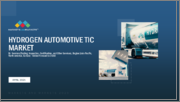
|
시장보고서
상품코드
1726993
유럽의 전기자동차 배터리 시험, 검사, 인증 시장 : 차량 유형별, 스테이지 유형별, 서비스 유형별, 추진 유형별, 배터리 유형별, 시험 파라미터 유형별, 국가별 - 분석 및 예측(2024-2034년)Europe Electric Vehicle Battery Testing, Inspection, and Certification Market: Focus on Vehicle Type, Stage Type, Service Type, Propulsion Type, Battery Type, Testing Parameter Type, and Country-Level Analysis - Analysis and Forecast, 2024-2034 |
||||||
유럽의 전기자동차 배터리 시험, 검사, 인증 시장 규모는 2024년 4억 1,090만 달러에서 2034년에는 22억 1,110만 달러에 이를 것으로 예측되며, 예측 기간 2024-2034년 CAGR 18.33%로 성장이 전망되고 있습니다.
국내 및 EU의 엄격한 배터리 규제, 전기자동차의 인기가 높아지고 지속적인 시험 기술의 진보가 유럽의 산업 확대의 주요 원동력이 되고 있습니다. 열폭주, 용량 저하, 성능 저하 등의 위험성을 줄임으로써 철저한 시험, 검사, 인증 서비스를 통해 EV 배터리의 안전성, 신뢰성, 규제 준수가 검증됩니다. 시장 확대는 EU의 인센티브와 지속 가능성 목표에 의해 더욱 가속화됩니다.
| 주요 시장 통계 | |
|---|---|
| 예측 기간 | 2024-2034년 |
| 평가(2024년) | 4억 1,090만 달러 |
| 예측(2034년) | 22억 1,110만 달러 |
| CAGR | 18.33% |
EV 배터리 시험, 검사, 인증 시장은 EU법의 엄격화와 전기자동차의 보급에 따라 유럽에서 크게 성장하고 있습니다. EU 배터리 규칙, UN 38.3, CE 마킹 등의 틀 하에서 서비스에는 환경 스트레스 스크리닝, 안전성과 학대 프로토콜(열폭주와 단락시험 포함), 셀과 팩 수준에서의 성능시험, 라이프사이클 및 용량 유지 분석, 형식승인 인증 등이 포함됩니다.
각국의 시험소 인가와 ISO17025 인증은 유럽의 시험 인프라 전체의 통일성과 정당성을 보증하고 있습니다. 디지털 트윈 모델링, AI를 활용한 진단, 높은 처리량의 자동화 리그, 고도의 열량 측정은 처리량, 정확도, 비용 효율을 향상시킨 기술적 진보의 한 예입니다. 현지 기가팩토리랩이나 전문적인 수탁시험 네트워크는 현지에서의 배터리 제조나 순환경제 대처에 대한 정부의 인센티브 강화로 확대되고 있습니다.
상대방 상표 제품 제조업체(OEM)와 Tier 1 공급업체는 파트너십과 자사 설비 투자의 균형을 잘 맞추어 물류 위험을 줄이고 엄격한 형식 승인 일정을 준수하고 있습니다. 세컨드 라이프 배터리의 시장 확대에 의해 재이용 증명서, 등급 매김 절차, 건전성 평가의 필요성이 높아지고 있습니다. 유럽의 강력한 EV 전개 계획, 보다 엄격한 안전 규제, 배터리 주권에 대한 전략적 추진으로 시장은 고도의 설비에 대한 높은 자본 요건, 시험 기준의 변화, 숙련 노동자 부족 등의 장애에도 불구하고 2020년대 후반까지 두 자릿수의 CAGR로 성장할 것으로 예상됩니다.
동향
- EU 배터리 규제, CE 마킹, UN 38.3별 안전 및 성능 프로토콜의 조화에 의한 인증의 합리화
- AI 구동 진단, 디지털 트윈 시뮬레이션, 높은 처리량 자동 시험 장치 도입
- 리드 타임을 단축하기 위한 계약 실험실 네트워크와 함께, 기가팩토리에서의 현장 시험 능력 확대
- 차세대 화학제품 및 급속 충전의 이용 사례에 특화한 열 관리 및 부정 사용 시험 서비스
촉진요인
- 안전, 성능, 환경 컴플라이언스에 관한 엄격한 시험, 검사, 인증을 의무화하는 EU 및 각국의 엄격한 규제
- 유럽에서의 EV의 급속한 보급에 따라, OEM이나 Tier-1 공급자가 인가의 타임라인에 맞추어 사내 시험 및 아웃소싱 시험에 투자
- 배터리 재료 및 배터리 팩의 설계의 진보에 의해 전기적, 기계적, 열적, 안전성 학대 시험 수요 증가
- EU가 전지의 주권을 전략적으로 중시해, 시험 인프라나 인정 기관에의 현지 투자를 촉진
과제
- 고도의 시험 설비에 걸리는 높은 자본 비용과 운용 비용, 숙련된 시험 소요원의 한정된 이용 가능성
- 급속히 진화하는 규제 상황에 따라 시험 프로토콜이나 인증 기준의 빈번한 갱신이 필요
- 국경을 넘은 서비스 제공을 복잡하게 하고 있는 단편적인 국가 인정 제도와 데이터 주권 규칙
- 세컨드 라이프 및 리사이클의 인프라가 한정되어 있어, 재이용 배터리의 검사와 인증과의 갭
이 보고서는 유럽의 EV 배터리 테스트, 검사 및 인증 시장에 대한 귀중한 인사이트를 제공하고 전략적 의사 결정과 시장 예측에 필요한 지식을 기업에 제공합니다. 본 보고서는 신흥 기술, 규제 변화, 경쟁 역학을 포괄적으로 분석하여 기업이 성장 기회를 파악하고 변화하는 업계의 요구에 맞게 제품을 제공할 수 있도록 지원합니다. 게다가 주요한 시장 참가 기업, 그 전략, 비즈니스 모델을 상세하게 조사하고 있어, 경합 정세 속에서 기업이 우위에 서는 것을 가능하게 합니다. 규제와 컴플리언스에 관한 인사이트도 커버하고 있어, 국제적인 시험 규격, 안전 규제, 지속 가능성에 대한 대처에 대해 상세한 평가를 실시해, 시장에 대한 대응을 확실하게 하고 있습니다. 게다가 지역별 및 부문별 분석에 의해, 다양한 시장의 성장 패턴, 과제, 기회를 분명히 해, 과녁을 좁힌 시장 참가 및 확대 전략을 서포트합니다. 본 보고서의 조사 결과를 활용함으로써 기업은 혁신을 추진하고, 업무 효율을 향상시키며, 진화하는 EV 배터리 시험과 인증 정세에서 경쟁 우위를 확보할 수 있습니다.
본 보고서에서는 유럽의 전기자동차 배터리 시험, 검사, 인증 시장에 대해 조사했으며, 시장 개요와 함께 차량 유형별, 스테이지 유형별, 서비스 유형별, 추진 유형별, 배터리 유형별, 시험 파라미터 유형별, 국가별 동향 및 시장 진출기업 프로파일 등의 정보를 제공합니다.
목차
주요 요약
제1장 시장 : 업계 전망
- 동향 : 현상과 장래에 대한 영향 평가
- 배터리 시험에서 디지털 트윈의 도입
- 무선 및 자동 테스트 시스템
- 배터리 시험에서 AI 및 머신러닝
- 투명한 인증 및 테스트를 위한 블록체인
- 배터리 검사에서 자동화 및 로봇 공학
- 차세대 EV 배터리용 선진 재료 시험
- 배터리 인증을 위한 시뮬레이션 및 예측 분석의 혁신
- 재사용 배터리 테스트 및 재활용 용도
- 공급망 개요
- 연구개발 리뷰
- 규제 상황
- 서비스 개요
- 시험
- 검사
- 인증
- COVID-19의 업계에 대한 영향
- 시장 역학 개요
제2장 지역
- 지역의 요약
- 유럽
- 지역 개요
- 시장 성장 촉진요인
- 시장 성장 억제요인
- 독일
- 프랑스
- 영국
- 스페인
- 스웨덴
- 폴란드
- 기타
제3장 시장-경쟁 환경 및 기업 프로파일
- 향후 전망
- 지리적 평가
- 경쟁 구도
- 기업 프로파일
- DEKRA SE
- TUV SUD
- SGS Societe Generale de Surveillance SA
- Applus
- Bureau Veritas
- Intertek Group plc
- TUV Rheinland
- VDE Renewables GmbH
- TUV NORD GROUP
- DNV GL
- Element Materials Technology
제4장 조사 방법
AJY 25.05.26Introduction to Europe Electric Vehicle Battery Testing, Inspection, and Certification Market
The Europe EV battery testing, inspection, and certification market is projected to reach $2,211.1 million by 2034 from $410.9 million in 2024, growing at a CAGR of 18.33% during the forecast period 2024-2034. Strict national and EU battery restrictions, the growing popularity of electric vehicles, and ongoing testing technology advancements are the main drivers of Europe's industry expansion. By reducing hazards like thermal runaway, capacity fade, and performance loss, thorough testing, inspection, and certification services verify EV battery safety, dependability, and regulatory compliance. Market expansion is further accelerated by EU incentives and sustainability goals.
Market Introduction
| KEY MARKET STATISTICS | |
|---|---|
| Forecast Period | 2024 - 2034 |
| 2024 Evaluation | $410.9 Million |
| 2034 Forecast | $2,211.1 Million |
| CAGR | 18.33% |
The market for EV battery testing, inspection, and certification has grown significantly in Europe as a result of stricter EU laws and a rise in the use of electric vehicles. Under frameworks such as the EU Battery Regulation, UN 38.3, and CE marking, services include environmental stress screening, safety and abuse protocols (including thermal runaway and short-circuit tests), performance testing at the cell and pack level, lifecycle and capacity retention analysis, and type-approval certification.
National laboratory authorisations and ISO 17025 accreditation guarantee uniformity and legitimacy throughout Europe's testing infrastructure. Digital twin modelling, AI-powered diagnostics, high-throughput automated rigs, and sophisticated calorimetry are examples of technological advancements that have improved throughput, accuracy, and cost-efficiency. On-site gigafactory labs and specialised contract-testing networks are expanding because to increased government incentives for local battery manufacture and circular economy efforts.
Original Equipment Manufacturers (OEMs) and Tier 1 suppliers are reducing logistical risks and meeting strict type-approval schedules by striking a balance between partnerships and in-house facility investments. The expanding market for second-life batteries increases the need for repurposing certificates, grading procedures, and state-of-health evaluations. With Europe's strong EV rollout plans, stricter safety regulations, and strategic push for battery sovereignty, the market is expected to grow at a double-digit CAGR through the late 2020s despite obstacles like high capital requirements for sophisticated equipment, changing test standards, and a shortage of skilled labour.
Market Segmentation
Segmentation 1: By Vehicle Type
- Passenger Vehicles
- Commercial Vehicles
Segmentation 2: By Stage Type
- Pre-Production Testing
- Post-Production Testing
Segmentation 3: By Battery Type
- Lithium-Ion
- Lead Acid
- Others
Segmentation 4: By Service Type
- Testing
- Inspection
- Certification
Segmentation 5: By Sourcing Type
- In-House
- Outsourced
Segmentation 6: By Propulsion Type
- Battery Electric Vehicles (BEVs)
- Plug-In Hybrid Electric Vehicles (PHEVs)
- Hybrid Electric Vehicles (HEVs)
Segmentation 7: By Testing Parameter Type
- Electrical Testing
- Mechanical Testing
- Thermal Testing
- Electromagnetic Compatibility (EMC) Testing
- Chemical Testing
- Others
Segmentation 8: By Region
- Europe: Germany, France, U.K., Spain, Sweden, Poland, Rest-of-Europe
Europe Electric Vehicle Battery Testing, Inspection, and Certification Market Trends, Drivers and Challenges
Trends
- Harmonization of safety and performance protocols under the EU Battery Regulation, CE-marking and UN 38.3 to streamline certification.
- Deployment of AI-driven diagnostics, digital-twin simulations and high-throughput automated testing rigs.
- Expansion of on-site testing capacity at gigafactories alongside contract-lab networks to reduce lead times.
- Specialized thermal-management and abuse-testing services for next-gen chemistries and fast-charging use cases.
Drivers
- Stringent EU and national regulations mandating rigorous testing, inspection and certification for safety, performance and environmental compliance.
- Rapid EV adoption in Europe, prompting OEMs and Tier-1 suppliers to invest in in-house and outsourced testing to meet approval timelines.
- Advances in battery materials and pack designs increasing demand for electrical, mechanical, thermal and safety-abuse testing.
- EU strategic focus on battery sovereignty, driving local investment in testing infrastructure and accreditation bodies.
Challenges
- High capital and operational costs for advanced testing equipment and limited availability of skilled lab personnel.
- Rapidly evolving regulatory landscape requiring frequent updates to test protocols and certification criteria.
- Fragmented national accreditation schemes and data-sovereignty rules complicating cross-border service delivery.
- Limited second-life and recycling infrastructure, creating gaps in inspection and certification for repurposed batteries.
How can this report add value to an organization?
This report provides invaluable insights into the Europe EV battery testing, inspection, and certification market, equipping organizations with the knowledge needed for strategic decision-making and market forecasting. It comprehensively analyzes emerging technologies, regulatory shifts, and competitive dynamics, helping businesses identify growth opportunities and align their offerings with evolving industry needs. Additionally, the report provides an in-depth examination of key market players, their strategies, and business models, enabling organizations to stay ahead in a competitive landscape. Regulatory and compliance insights are also covered, offering a detailed assessment of international testing standards, safety regulations, and sustainability initiatives to ensure market readiness. Furthermore, regional and segmentation analyses shed light on growth patterns, challenges, and opportunities across different markets, supporting targeted market entry and expansion strategies. By leveraging the findings of this report, businesses can drive innovation, enhance operational efficiency, and secure a competitive advantage in the evolving EV battery testing and certification landscape.
Key Market Players and Competition Synopsis
The companies that are profiled in the Europe electric vehicle (EV) battery testing, inspection, and certification market have been selected based on inputs gathered from primary experts who have analyzed company coverage, product portfolio, and market penetration.
Some of the prominent names in this market are:
- DEKRA SE
- TUV SUD
- SGS Societe Generale de Surveillance SA
- Applus+
- Bureau Veritas
- Intertek Group plc
- TUV Rheinland
- VDE Renewables GmbH
- TUV NORD GROUP
- DNV GL
- Element Materials Technology
Table of Contents
Executive Summary
Scope and Definition
1 Market: Industry Outlook
- 1.1 Trends: Current and Future Impact Assessment
- 1.1.1 Adoption of Digital Twins in Battery Testing
- 1.1.2 Wireless and Automated Testing Systems
- 1.1.3 AI and Machine Learning in Battery Testing
- 1.1.4 Blockchain for Transparent Certification and Testing
- 1.1.5 Automation and Robotics in Battery Inspection
- 1.1.6 Advanced Material Testing for Next-Gen EV Batteries
- 1.1.7 Innovations in Simulation and Predictive Analytics for Battery Certification
- 1.1.8 Testing of Second-Life Batteries and Recycling Applications
- 1.2 Supply Chain Overview
- 1.2.1 Key Stakeholders
- 1.2.1.1 Raw Material Testing
- 1.2.1.2 Battery Manufacturing and Integration
- 1.2.1.3 Testing and Certification Service Providers
- 1.2.1.4 End-Use Industries
- 1.2.2 Value Chain Analysis
- 1.2.3 Pricing Forecast
- 1.2.1 Key Stakeholders
- 1.3 Research and Development Review
- 1.3.1 Patent Filing Trend (by Country and Company)
- 1.4 Regulatory Landscape
- 1.5 Services Overview
- 1.5.1 Testing
- 1.5.1.1 Performance Testing
- 1.5.1.2 Durability Testing
- 1.5.1.3 Electrical Testing
- 1.5.1.4 Thermal Testing
- 1.5.1.5 Abuse and Crash Testing
- 1.5.1.6 Non-Destructive Testing (NDT)
- 1.5.2 Inspection
- 1.5.2.1 Visual Inspection
- 1.5.2.2 Safety Inspection
- 1.5.2.3 Quality Control Inspection
- 1.5.3 Certification
- 1.5.3.1 Product Certification (ISO, IEC)
- 1.5.3.2 Safety and Compliance Certification
- 1.5.3.3 Environmental Certification (RoHS, WEEE)
- 1.5.3.4 Regulatory Certification
- 1.5.1 Testing
- 1.6 Impact of COVID-19 on the Industry
- 1.7 Market Dynamics Overview
- 1.7.1 Market Drivers
- 1.7.1.1 Rising Electric Car Sales Accelerating Demand for Reliable and Certified Batteries
- 1.7.1.2 Growing Emphasis on Safety Standards for EV Batteries
- 1.7.2 Market Challenges
- 1.7.2.1 High Costs of Advanced EV Battery Testing Equipment and Facilities
- 1.7.2.2 Lack of Standardized Testing and Certification Requirements for EV Batteries across Markets
- 1.7.3 Market Opportunities
- 1.7.3.1 Increasing Development of Next-Generation EV Batteries
- 1.7.3.2 Expanding Market for Second-Life Applications and Recycling of EV Batteries
- 1.7.1 Market Drivers
2 Regions
- 2.1 Regional Summary
- 2.2 Europe
- 2.2.1 Regional Overview
- 2.2.2 Driving Factors for Market Growth
- 2.2.3 Factors Challenging the Market
- 2.2.3.1 Application
- 2.2.3.2 Product
- 2.2.4 Germany
- 2.2.4.1 Application
- 2.2.4.2 Product
- 2.2.5 France
- 2.2.5.1 Application
- 2.2.5.2 Product
- 2.2.6 U.K.
- 2.2.6.1 Application
- 2.2.6.2 Product
- 2.2.7 Spain
- 2.2.7.1 Application
- 2.2.7.2 Product
- 2.2.8 Sweden
- 2.2.8.1 Application
- 2.2.8.2 Product
- 2.2.9 Poland
- 2.2.9.1 Application
- 2.2.9.2 Product
- 2.2.10 Rest-of-Europe
- 2.2.10.1 Application
- 2.2.10.2 Product
3 Markets - Competitive Landscaped and Companies Profiled
- 3.1 Next Frontiers
- 3.2 Geographical Assessment
- 3.3 Competitive Landscape
- 3.4 Company Profiles
- 3.4.1 DEKRA SE
- 3.4.1.1 Overview
- 3.4.1.2 Top Products/Product Portfolio
- 3.4.1.3 Top Competitors
- 3.4.1.4 Target Customers/End-Use Industries
- 3.4.1.5 Key Personnel
- 3.4.1.6 Analyst View
- 3.4.1.7 Market Share, 2023
- 3.4.2 TUV SUD
- 3.4.2.1 Overview
- 3.4.2.2 Top Products/Product Portfolio
- 3.4.2.3 Top Competitors
- 3.4.2.4 Target Customers/End-Use Industries
- 3.4.2.5 Key Personnel
- 3.4.2.6 Analyst View
- 3.4.2.7 Market Share, 2023
- 3.4.3 SGS Societe Generale de Surveillance SA
- 3.4.3.1 Overview
- 3.4.3.2 Top Products/Product Portfolio
- 3.4.3.3 Top Competitors
- 3.4.3.4 Target Customers/End-Use Industries
- 3.4.3.5 Key Personnel
- 3.4.3.6 Analyst View
- 3.4.3.7 Market Share, 2023
- 3.4.4 Applus+
- 3.4.4.1 Overview
- 3.4.4.2 Top Products/Product Portfolio
- 3.4.4.3 Top Competitors
- 3.4.4.4 Target Customers/End-Use Industries
- 3.4.4.5 Key Personnel
- 3.4.4.6 Analyst View
- 3.4.4.7 Market Share, 2023
- 3.4.5 Bureau Veritas
- 3.4.5.1 Overview
- 3.4.5.2 Top Products/Product Portfolio
- 3.4.5.3 Top Competitors
- 3.4.5.4 Target Customers/End-Use Industries
- 3.4.5.5 Key Personnel
- 3.4.5.6 Analyst View
- 3.4.5.7 Market Share, 2023
- 3.4.6 Intertek Group plc
- 3.4.6.1 Overview
- 3.4.6.2 Top Products/Product Portfolio
- 3.4.6.3 Top Competitors
- 3.4.6.4 Target Customers/End-Use Industries
- 3.4.6.5 Key Personnel
- 3.4.6.6 Analyst View
- 3.4.6.7 Market Share, 2023
- 3.4.7 TUV Rheinland
- 3.4.7.1 Overview
- 3.4.7.2 Top Products/Product Portfolio
- 3.4.7.3 Top Competitors
- 3.4.7.4 Target Customers/End-Use Industries
- 3.4.7.5 Others Key Personnel
- 3.4.7.6 Analyst View
- 3.4.7.7 Market Share, 2023
- 3.4.8 VDE Renewables GmbH
- 3.4.8.1 Overview
- 3.4.8.2 Top Products/Product Portfolio
- 3.4.8.3 Top Competitors
- 3.4.8.4 Target Customers
- 3.4.8.5 Key Personnel
- 3.4.8.6 Analyst View
- 3.4.8.7 Market Share, 2023
- 3.4.9 TUV NORD GROUP
- 3.4.9.1 Overview
- 3.4.9.2 Top Services/Service Portfolio
- 3.4.9.3 Top Competitors
- 3.4.9.4 Target Customers
- 3.4.9.5 Key Personnel
- 3.4.9.6 Analyst View
- 3.4.9.7 Market Share, 2023
- 3.4.10 DNV GL
- 3.4.10.1 Overview
- 3.4.10.2 Top Services/Service Portfolio
- 3.4.10.3 Top Competitors
- 3.4.10.4 Target Customers
- 3.4.10.5 Key Personnel
- 3.4.10.6 Analyst View
- 3.4.10.7 Market Share, 2023
- 3.4.11 Element Materials Technology
- 3.4.11.1 Overview
- 3.4.11.2 Top Services/Service Portfolio
- 3.4.11.3 Top Competitors
- 3.4.11.4 Target Customers
- 3.4.11.5 Key Personnel
- 3.4.11.6 Analyst View
- 3.4.11.7 Market Share, 2023
- 3.4.1 DEKRA SE
4 Research Methodology
- 4.1 Data Sources
- 4.1.1 Primary Data Sources
- 4.1.2 Secondary Data Sources
- 4.1.3 Data Triangulation
- 4.2 Market Estimation and Forecast



















